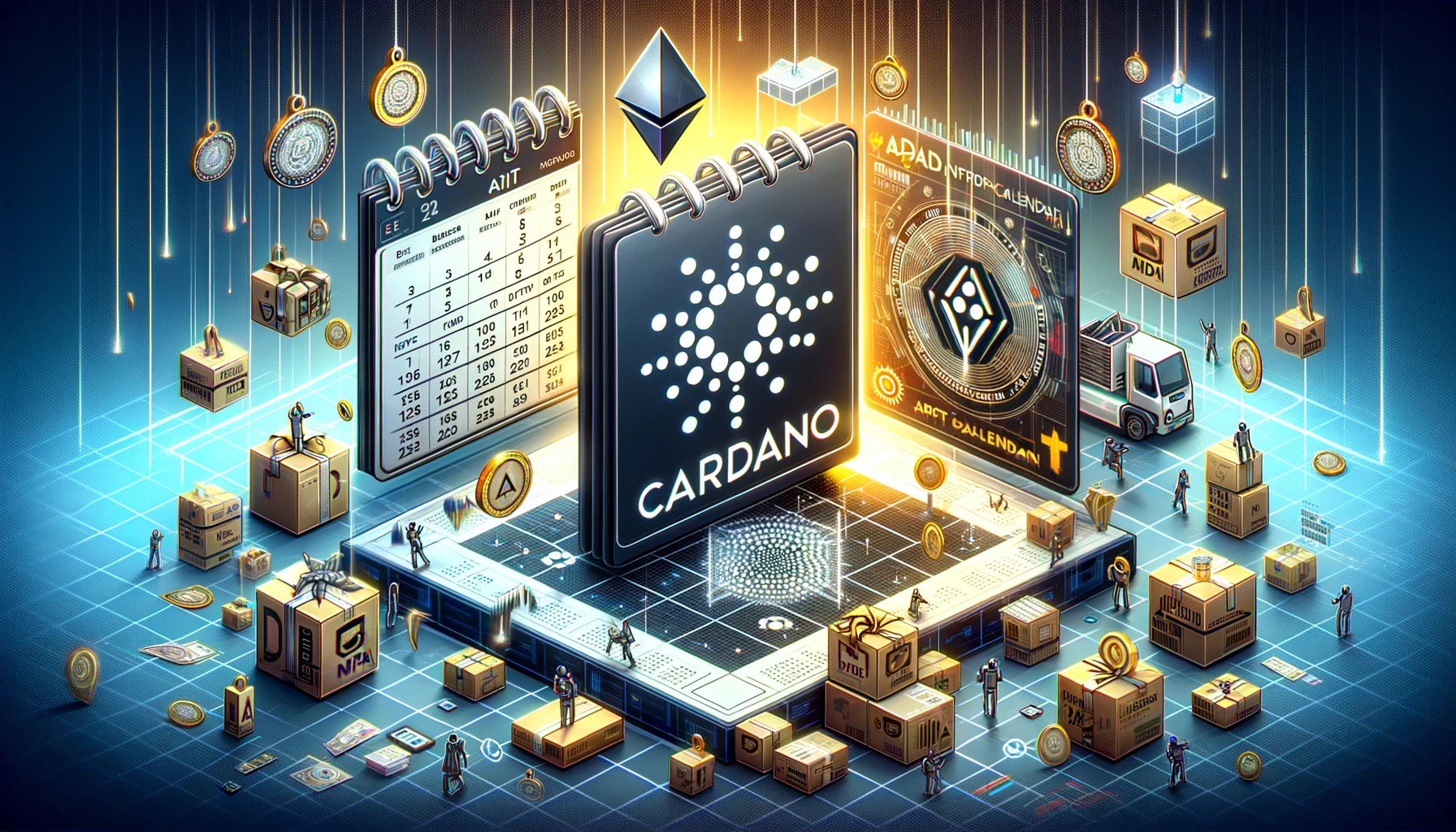How to Check Rarity on Your NFT Asset using Rarity.Tools
August 27, 2021 - 12 min read
Learn how to check the rarity of your NFT asset step-by-step using Rarity.Tools. Combine with Opensea sales data to find undervalued NFT assets.
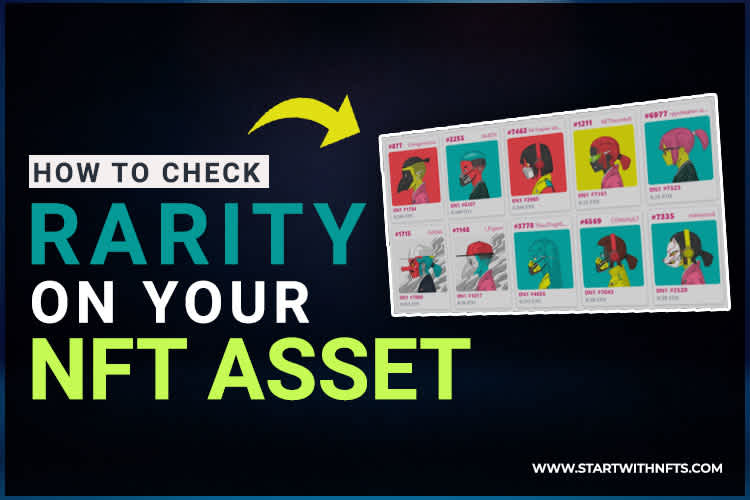
Updated Apr 22nd, 2023
NFT Rarity: Introduction to Checking Rarity with Rarity.Tools
The NFT market is booming, and rarity is one of the key factors that make certain digital assets more valuable than others.
Whether it's because of the asset's historical significance, technological innovation, art, cultural relevance, or simply its rarity, understanding the rarity of your NFT can help you make better-informed decisions as a trader or collector.
There’s also a significant value difference between assets in certain projects, which is largely attributed to the rarity of those assets.
Many new projects are launching in sets of 10,000 assets, typically avatar-type characters with hundreds of different feature combinations. For example, some CryptoPunks sold for $5+ million dollars while others sold for $1.02 million.
What makes them worth such staggeringly different prices?
Rarity.
In this article, we will guide you step-by-step on how to check the rarity of your NFT asset using Rarity.Tools and how to combine it with OpenSea data to find undervalued NFT assets.
How Rarity.Tools Works
Rarity.Tools is a web-based tool that helps you determine the rarity of your NFT asset. The tool uses a mathematical formula to calculate the rarity score of each NFT asset. It factors in the rarity of all traits that comprise an asset, rather than ranking based on assets with the rarest singular traits. This means that Rarity.Tools provides a more accurate picture of an NFT asset's rarity, helping you make better investment decisions.
The Benefits of Using Rarity.Tools for Checking NFT Rarity
There are several benefits to using Rarity.Tools for checking NFT rarity, including:
Accuracy: Rarity.Tools provides a more accurate picture of an NFT asset's rarity by factoring in the rarity of all traits that comprise an asset.
Efficiency: Rarity.Tools simplifies the process of ranking each asset by rarity, saving you time and effort.
Pricing: Rarity.Tools helps you properly price an item and avoid overpaying for a less rare asset.
Investment decisions: Knowing the rarity of your NFT asset can help you make better investment decisions.
Step-by-Step Guide: How to Check the Rarity of Your NFT Asset with Rarity.Tools
You can check the rarity of your NFT by going to Rarity.Tools. Click "All Collections", search for your project, type in your OpenSea asset ID under "ID" and click "Look Up". You'll see the rank of your NFT out of the total NFTs in the collection. E.g. 4th out of 4,500.
We are going to go through these exact steps together, in detail, and I'm going to show you how to use Rarity.Tools and OpenSea to properly price your NFT asset and find underpriced NFTs.
When you mint or buy an NFT, it is usually part of a larger collection.
Rarity Tools can help you figure out how rare your asset is out of the entire collection it’s part of. It's my favorite NFT rarity tool to use to check NFT rarity and I'm going to show you exactly how to use it step-by-step.
For example, let’s say you mint or buy an asset from the 0N1 Force NFT project that has 7,777 individual assets.
Out of those 7,777 assets, how does yours stack up in terms of rarity compared to the other assets?
The problem is that while the traits of an asset (and its rarity) are listed on Opensea, it can be difficult and time-consuming to compare assets:
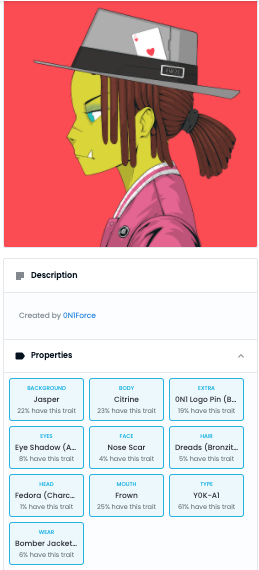
Source: Opensea.io
Rarity tools simplifies this process for us by ranking each asset by rarity, so we don’t have to do it by hand to more quickly analyze the data. This tool is critical to help you properly price an item, avoid overpaying for a less rare asset, and find good prices on rare assets.
Open Rarity.tools and click on the “All Collections” tab in the main menu:
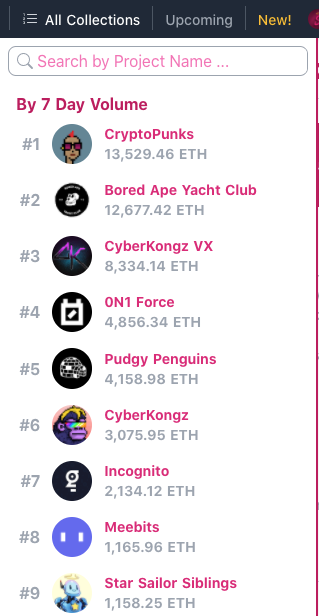
Source: Rarity.tools
You can search for a project in the toolbar if it isn’t listed in the top projects.
Note: If your project isn’t popping up on Rarity.tools, double-check the spelling, but it could also mean that the project hasn’t been listed yet.
After clicking on 0N1 Force, I am taken to a page that shows every single asset ranking by its rarity:
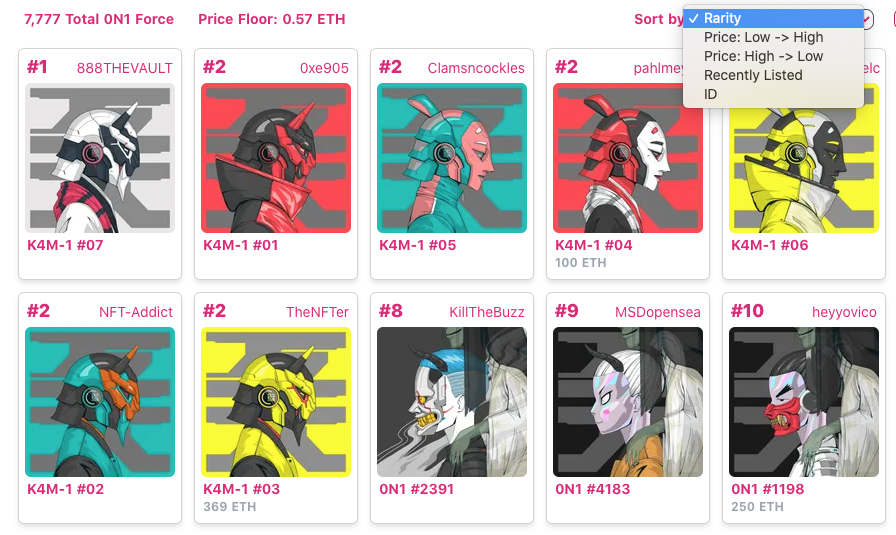
Source: Rarity.Tools
This page displays the number of assets, the current floor price, and a filter for Rarity, Price, Recently listed and asset ID.
If you own an asset from the project, you’ll want to grab its ID number from OpenSea so you can search for it on Rarity.tools:
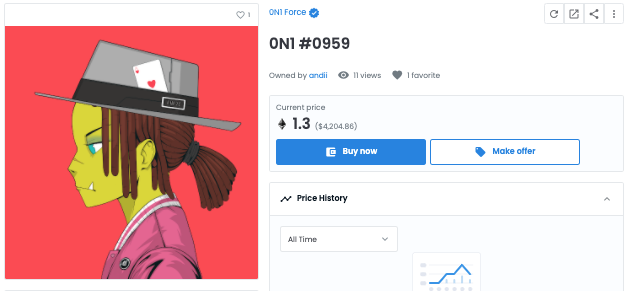
Source: Opensea.io
Note: This is not my asset.
The ID on this asset is #0959.
Copy that ID and paste it into the “ID” form bubble under the Project tab on the left-hand side of the page:
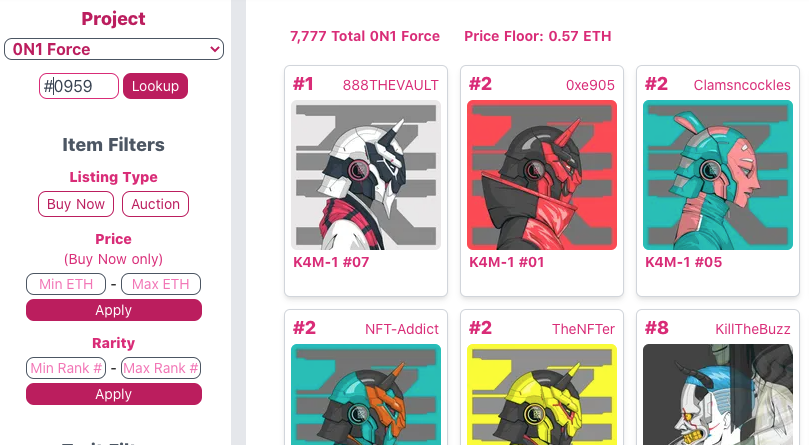
Source: Rarity.tools
Click the “Lookup” button and it will return your result with both a numerical ranking and breakdown of the rarity traits:
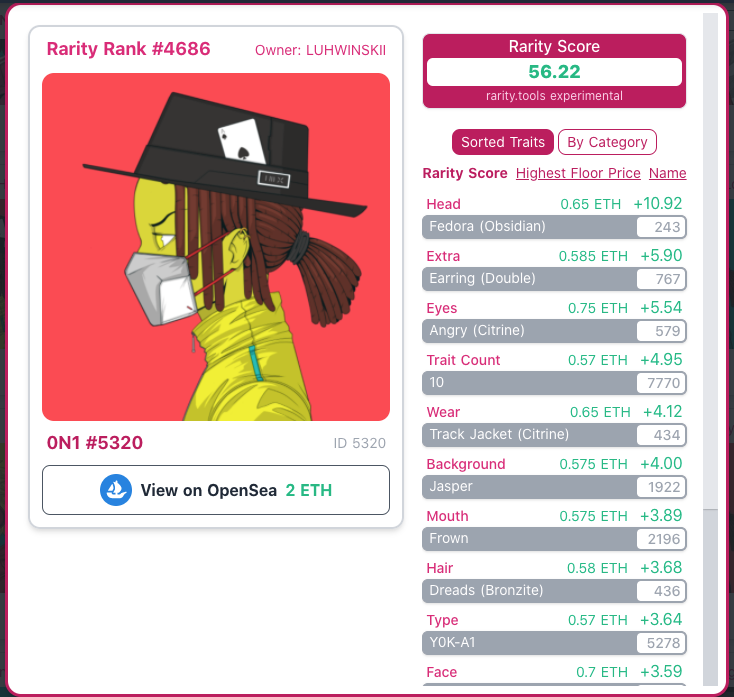
Source: Rarity.Tools
Despite having some rare traits (like a Fedora at just 1% of total supply), this asset is ranked #4,686 out of the 7,777 assets in the project with a rarity score of 56.22.
Instead of playing a guessing game about how rare your asset is, leverage rarity.tools to quickly find out where your assets rank in the project.
How Rarity.Tools Calculates NFT Rarity: A Breakdown of the Formula
Rarity.tools leverages a mathematical formula to produce a rarity score based on the traits of an asset:
“[Rarity Score for a Trait Value] = 1 / ([Number of Items with that Trait Value] / [Total Number of Items in Collection])
The total Rarity Score for an NFT is the sum of the Rarity Score of all of it’s trait values.”
Rather than ranking based on assets with the rarest singular traits, Rarity.tools factors in the rarity of all traits that comprise an asset.
This means that although our asset from the example in the previous section has a 1% trait, it does not put that it in the top 1% of assets in the project. The tool looks at the whole picture. If you want a more detailed write-up from Rarity.tools about their chosen methodology, you can find that here.
It’s also worth considering that the market ultimately determines the value of an NFT. Rarity.tools has chosen a model they believe in, but you may come across a project where one trait significantly outweighs others in terms of desirability.
Buying NFTs with Rarity.Tools: Tips for Finding Undervalued NFT Assets
If you are going to buy an avatar NFT, you shouldn’t do so until you use this tool. While there are some projects where a ranking wouldn’t be as useful (they’re likely unlisted anyway) it’s worth making a habit of checking it before pressing “Buy Now”.
If you are savvy and looking for an advantage of the market, I recommend filtering by “Price: Low -> High”.
The result will show you assets with the lowest pricing and their rarity ranking:
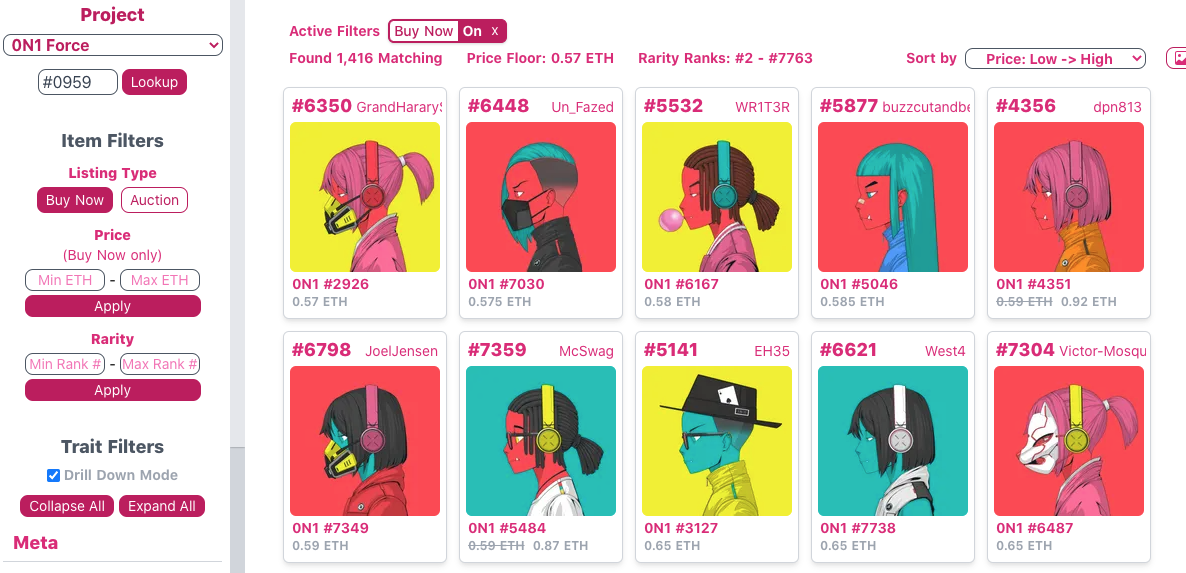
Source: Rarity.tools
If you have a budget in mind (which I strongly encourage), you can find the rarest item for the price that fits your budget.
You may also be able to find rare assets that are underpriced. Not everyone checks Rarity.tools before selling, so this may give you an advantage.
As you recall, rarity.tools isn’t the ultimate point of truth. There may be a trait you notice that stands out in the project.
For example, you might notice the avatar for sale at 0.58 ETH with the rarity rank of #5532 that has a bubble gum trait:

Source: Rarity.tools
You can leverage OpenSea.io’s filtering capability to look at the pricing of assets that have this trait to see the lowest floor price:
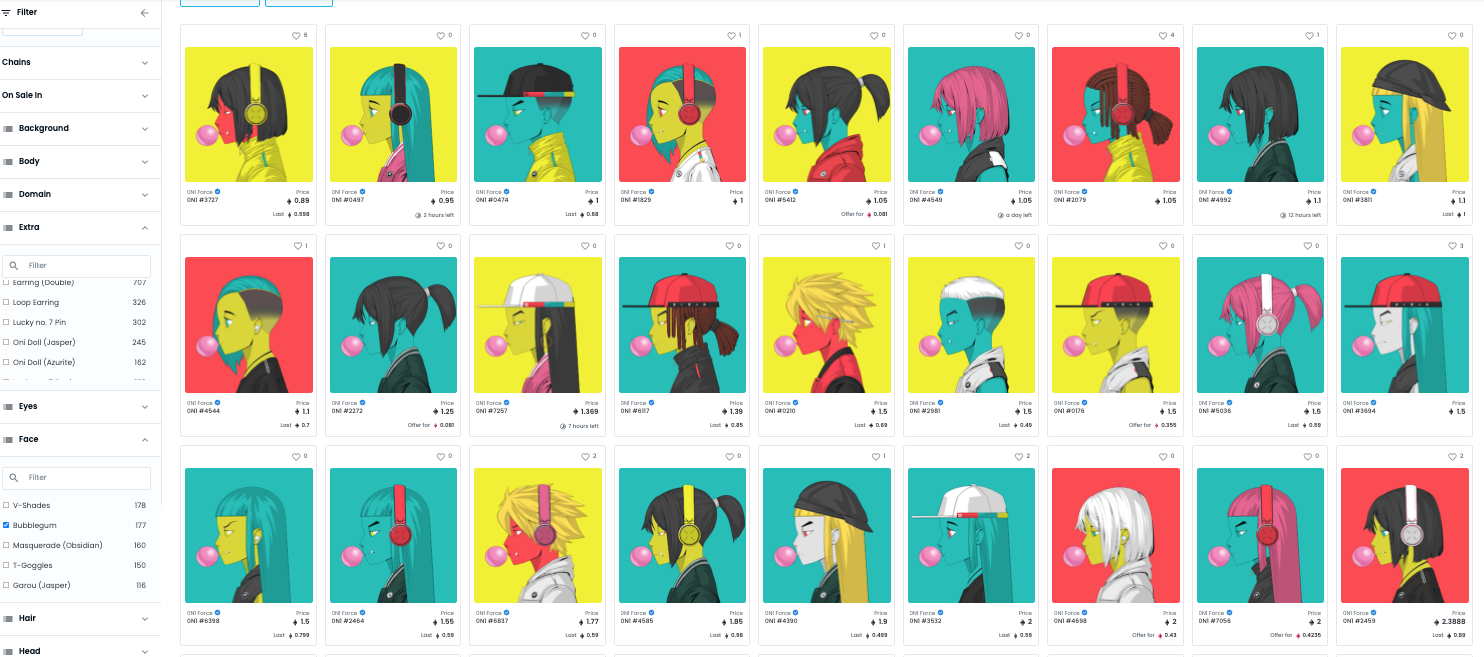
Source: Opensea.io
You can also look at the highest last sale:

Source: Opensea.io
This may help you identify traits that are selling over their total rarity rank.
While the asset I identified has already been sold, I used OpenSea data to see that the lowest available buy-it-now price is 0.89 ETH.
I can then look at the highest last sale to get a feel for the demand of a certain trait, and in this case, it was 1.1 ETH.
Personally, I am a fan of the bubblegum trait, but based on the data, the market hasn’t awarded it at a premium.
If that asset were for sale at 0.58, I would have purchased it. There are just 177 assets with bubblegum, the floor is more than .3 ETH higher, and the highest sale got over 1 ETH.
It’s important to think for yourself and do your own research, but this example gives you an idea for how to do just that.
Combining rarity.tools and Opensea data can give you an advantage in the market and help you move faster by removing the guesswork of rarity for assets in an NFT project.
Additional NFT Rarity Tools and Techniques to Check Your NFT Asset Rarity
The NFT market has grown considerably since this article was first released in September.
In that time, NFTs on the Solana blockchain have grown in popularity, new rarity tools have been released, and new loopholes have been discovered that allow you to check the rarity of NFTs before assets are revealed on OpenSea.
Rarity.tools is still the top NFT tool we use to check the rarity of our NFTs, but if you need an alternative rarity checker for Solana NFTs, check out: Howrare.is.
Howrare.is boasts 1.33 million items across 290 collections and has a user interface similar to Rarity.Tools. It allows you to enter your Solana NFT asset ID and gives a numerical rank, a rarity score, and attribute count.
And if you're looking for rarity rankings of NFT projects across multiple blockchains, check out RaritySniper.com.
RaritySniper.com features 842 collections from 11 blockchains:
1. Ethereum
2. Solana
3. Polygon
4. Binance
5. Cronos
6. Arbitrum
7. Wax
8. IMX
9. Celo
10. Tron
11. Zilliqa
The majority of listed projects (750 out of 842) use the Ethereum blockchain, but it's useful to be able to quickly look at the rarity of assets from other blockchains.
Rarity Sniper has a really cool background story. It was initially launched as a Discord group, which you can join by clicking here. Its founder was initially sending Rarity Tools screenshots to users but the group blew up (to 350,000 users), so he built a website for users to check rarity themselves. The site received 1 million unique visitors in the first month.
You can read more about that story on ONE37pm by clicking here.
And did you know that there is actually a way to view the rarity of your NFT asset before it is revealed on OpenSea? We just built a step-by-step guide for how to do this, which you can read by clicking here.
The summary is that most NFT assets are not stored on the blockchain because it is expensive to do this. Platforms like IPFS were built to reduce hosting costs of metadata (image, traits, description) of an NFT asset but some savvy users have figured out how to use this to their advantage and look at traits before an NFT reveals on OpenSea.
This is a market inefficiency that gives an advantage to those who know how to use Etherscan and IPFS to get this data.
Creators are getting smarter about hiding it, but you don't want to be the one to sell a rare NFT asset before reveal without knowing it, so it's best to run through these steps and double-check before you make a sale.
It's also important to stay liquid (have ETH available for a purchase) in case a rare asset does pop up that you think is underpriced.
If you have extra money that you can afford to lose, consider signing up for Coinbase and purchasing some Ethereum so that you can buy NFTs. You can check out our full how-to guide to buying and selling an NFT here if you are having trouble, but we personally use Coinbase and trust the platform.
Disclosure: The above link to Coinbase is an affiliate link and we receive a small commission if you sign up for their product at no cost to you. We only recommend products that we've personally used and well . . . we have used Coinbase a lot. You can read my full affiliate disclosure here.
We also strongly encourage our readers to consider purchasing a hardware wallet, which starts at $59. I've been using the Ledger Nano X since last July and it helps me sleep better at night.
Hardware wallets like the Ledger S or Nano X are the most effective ways to protect your NFT assets from scams. The links to the Ledger product suite are affiliate links and we may receive a small commission if you choose to make a purchase. You can read my full affiliate disclaimer disclosure here.
If you want to protect yourself and your NFTs from scams and hacks, you can shop for Ledger Hardware wallets by clicking here.
FAQs about Checking NFT Rarity with Rarity.Tools
Here are some frequently asked questions about checking NFT rarity with Rarity.Tools:
1. What is the difference between rarity and trait in NFTs?
Rarity is a measure of how unique and scarce an NFT is compared to other NFTs in the same collection. Traits are the individual characteristics that make up an NFT. Rarity is determined by the combination of traits and their relative scarcity.
2. Can Rarity.Tools be used for all NFT collections?
No, Rarity.Tools may not have data for all NFT collections. It is important to check if your NFT collection is listed on Rarity.Tools. If it is not listed, you may need to use alternative tools to check the rarity of your NFTs.
3. Can rarity scores change over time?
Yes, rarity scores could change over time if new NFTs are added to the collection, NFTs from the collection are burned or even as the market demand for certain traits changes. It is important to keep checking rarity scores for your NFTs to stay informed about their value.
4. How can Rarity.Tools help with NFT purchases?
Rarity.Tools can help you identify undervalued NFTs by providing you with a rank of your NFT's rarity compared to others in the collection. You can also filter by price to find rare assets that are underpriced. This can help you make informed purchasing decisions and avoid overpaying for less rare assets.
Newsletter
Enter your email address below to subscribe to my newsletter
latest posts


